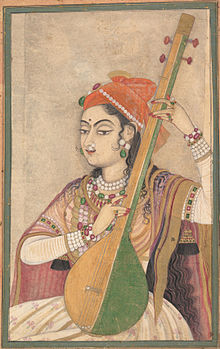Mizo music
| Music of India | |
|---|---|

A Lady Playing the Tanpura, ca. 1735 (Rajasthan)
|
|
| Genres | |
|
|
| Media and performance | |
| Music awards | |
| Music festivals | |
| Music media | |
| Nationalistic and patriotic songs | |
| National anthem | Jana Gana Mana |
| Regional music | |
|
|
Mizoram is a region in India. Its folk music consists of vocals (singing) accompanied by traditional drums, gong and other native percussion instruments. There is also a long history of flute-playing which is now defunct. The drums are made from a hollow tree trunk with membrane made from cow hide and the gongs, made of brass, are very similar to those found in Myanmar.
It is difficult to trace the origin, and to arrange the chronological sequences of the heritage of Mizo Music. However, some couplets were developed during the settlement of Thantlang in Burma, estimated between 1300-1400 AD. As recorded by B. Lalthangliana, the folk songs developed during this period were dar hla (songs on gong); Bawh hla (War chants), Hlado (Chants of hunting); Nauawih hla (Cradle songs) A greater development of songs can be seen from the settlement of Lentlang in Burma, estimated between late 15th to 17th Century AD.
The Mizo occupied the present Mizoram from the late 17th century. The pre-colonial period, that is from the 18th to 19th century A.D. was another important era in the history of Mizo folk literature. Prior to the annexation by the British Government, the Mizo occupied the present Mizoram for two centuries. In comparison with the folk songs of Thantlang and Lentlang settlement, the songs of this period are more developed in its number, form and contents. The languages are more polished and the flows also better. Most of the songs of this period are named after the composers.
The Mizos have a traditional way of classification of their folk songs. A study of their folksongs on the basis of their own system of classification shows that the Mizos have about one hundred different types of folksongs. But it can broadly be classified into ten as follows:
This is the chant or cry raised by the warriors when returning from successful raid. The warriors chant Bawh Hla to show their superiority over the enemy, and in order to let his people know that a successful raid has taken place. No other members of the warriors except the killer of the enemy can chant Bawh Hla.
This is the chant or cry raised by the hunters when a successful hunting has taken place. Chanting Hlado was done on the spot, or on the way home, or just before entering the village, or on the celebration. Anyone who witnessed his success could chant Hlado at any time and place.
These two verse forms are chanted by the Priests and the witch while performing ceremonies.
...
Wikipedia
